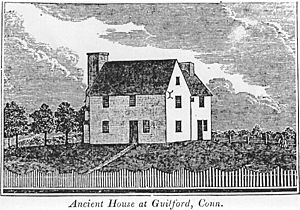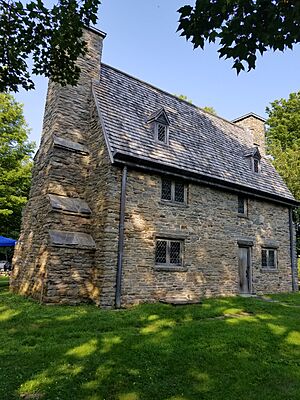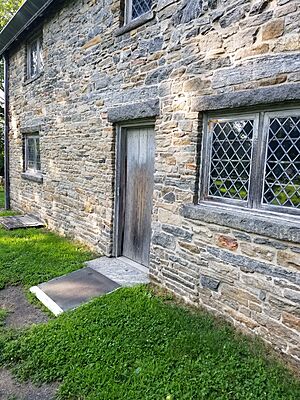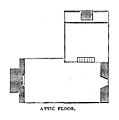Henry Whitfield House facts for kids
|
Henry Whitfield House
|
|
|
U.S. Historic district
Contributing property |
|
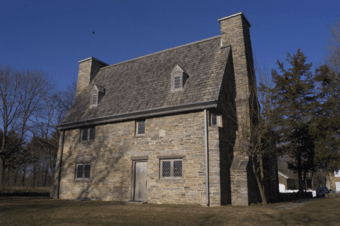
Henry Whitfield House, the oldest house in Connecticut and the oldest stone house in New England
|
|
| Location | 248 Old Whitfield Street, Guilford, Connecticut |
|---|---|
| Built | 1639 |
| Architectural style | American Colonial |
| Part of | Guilford Historic Town Center (ID76001988) |
| NRHP reference No. | 72001327 |
Quick facts for kids Significant dates |
|
| Added to NRHP | November 27, 1972 |
| Designated NHL | September 25, 1997 |
| Designated CP | July 6, 1976 |
The Henry Whitfield House is a very old and important house in Guilford, Connecticut. It was built way back in 1639, even before the town of Guilford was fully set up. This makes it the oldest house in Connecticut and the oldest stone house in all of New England!
The house was built for Henry Whitfield, a minister who came from England seeking religious freedom. Its strong stone walls also helped protect the early community like a fort. Over the years, the house was updated and then opened to the public in 1899 as the Henry Whitfield State Museum. It was the very first state museum in Connecticut! Today, it's recognized as a National Historic Landmark and a State Archeological Preserve.
Contents
Building the Oldest Stone House
The first settlers of the Guilford colony started building their minister's home in September 1639. They began a bit late in the year, so winter weather stopped them from finishing much more than half of the main room and one fireplace. By the summer of 1640, the settlers completed the rest of the main hall, the second floor, and the attic. That's when Henry Whitfield and his family moved in.
Local Menunkatuck Native Americans helped the settlers build the house. They carried heavy stones from nearby quarries to the building site. The walls of the house were made almost two feet thick because there was so much stone available. The original "glue" (mortar) that held the stones together was made from yellow clay and crushed oyster shells. This was a clever way to build when other materials were hard to find. Inside the main hall, the wooden beams were cut by hand from oak trees.
What the Whitfield House Was Used For
The Whitfield House was mainly the home for Henry Whitfield, his wife Dorothy, and their nine children. But it was used for many other things too!
- It was a place of worship before the first church was built in Guilford.
- It served as a meeting place for colonial town meetings.
- It was a strong fort to protect the settlers if there was an attack.
- It offered shelter for travelers moving between the New Haven and Saybrook colonies.
Today, the house is a museum. It's also a State Archeological Preserve, a National Historic Landmark, and listed on the National Register of Historic Places.
Unique Design of the House
The way the Henry Whitfield House was designed is quite special for its time and place. It looks more like the large homes found in northern England and Scotland, not the style common in other parts of New England. The settlers built big rooms, even though smaller rooms would have been easier to heat. They also chose to build with stone, even though there was plenty of wood available.
The original house had a kitchen and a large main hall on the first floor. This hall could be divided into two rooms. A stair tower led to the second floor, which had three bedrooms. Above them was a small attic. The great hall was likely the busiest room. It was 33 feet long and 15 feet wide. This room was used for church services, town meetings, parties, and hosting travelers.
The Whitfield family slept on the second floor. The room above the kitchen was probably used for the younger children because it stayed the warmest from the heat rising from the kitchen fireplace. The original roof was very steep. The house had six fireplaces. The largest one is over ten feet wide and is still mostly the same today.
About Henry Whitfield
Henry Whitfield was one of the founders of Guilford and its first minister. He was born in England in 1592. His father was a wealthy lawyer, and his mother was related to the famous writer Geoffrey Chaucer.
Henry Whitfield went to New College, Oxford, where he became friends with George Fenwick, who helped start the Saybrook Colony. Henry first studied law but decided he preferred ministry. He became a minister in 1618 and worked at a church in Ockley, England, for 18 years. People came from all around to hear his sermons. He was known for being kind, smart, and gentle.
Henry married Dorothy Sheafe, and they had nine children together. At this time, King Charles I and the Church of England were making it hard for Puritans who had different religious beliefs. Henry Whitfield started to agree with the Puritans. He was even criticized for his views in 1638, so he left his church job.
In early 1639, Whitfield decided to move to America with his family and followers. He gathered about 25 families, mostly farmers, to travel to the New Haven colony. An experienced builder named Edward Jones also came along.
When they arrived in June 1639, Whitfield bought land from the Quinnipiac tribe. This land was between the New Haven and Saybrook colonies. Whitfield and his followers started the Guilford colony in September. He was both the minister and the community leader, giving sermons, performing marriages, and settling disagreements.
By the late 1640s, things in England had changed. The strict religious policies were gone, and England became more accepting of different beliefs. Many people from New England, including ministers, started moving back to England. Whitfield also decided to return. Even though his community wanted him to stay, he left the colony on August 26, 1650, with his son John.
Dorothy Whitfield and most of their children stayed in Guilford. She continued to live in their stone house. Henry Whitfield died in England in 1657. Dorothy returned to England in 1659 and passed away in 1669.
Who Lived in the House Over Time
The first people to live in the house were Henry Whitfield, his wife Dorothy, and their children. They often welcomed travelers and community members. After Henry Whitfield returned to England in 1650, Dorothy and some of their children continued to live there.
The town of Guilford tried to buy the house to use as a school, but they didn't have enough money. In 1659, the house was sold to a merchant from London named Major Robert Thompson. His family owned the house for over 100 years, renting it out to farmers.
The house changed hands a few more times. One owner, Joseph Pynchon, used it as a summer home but had to leave during the American Revolution because he supported the British. Finally, the State of Connecticut bought the house in 1900. It was then turned into the museum we see today.
Making the House a Museum: Renovations
The Henry Whitfield House has been renovated several times to keep it standing and to make it a museum.
The first big renovation happened in 1868. Parts of the house, like the roof and a wall, were falling apart. Many repairs were made to make the house livable again. The south chimney was removed, and the roof was rebuilt. However, much of the original structure was kept.
The second major renovation was in 1902, after the museum opened. An expert named Norman Isham worked to make the house look good for visitors. He replastered walls and fixed the smaller fireplaces.
The most extensive renovation took place in the 1930s, led by J. Frederick Kelly. His goal was to restore the house to how it looked in 1639. This included rebuilding the kitchen and a wing of the house. Outside, the roof was made steeper, a chimney was added to the south end, and old-style windows with diamond-shaped glass were put in. Inside, a corner window was recreated, the stair tower was restored, and the second floor was rebuilt. This big project was finished in 1937.
The Henry Whitfield State Museum
The Henry Whitfield House officially opened as a museum in 1899. It was the first state museum in Connecticut! The museum is managed by the Connecticut Department of Economic and Community Development.
Some items in the museum were found in the house's cellar. Many other artifacts were brought from other historic sites of the same time period. This helps visitors imagine what life was like for the early American colonists. Visitors can explore the house with a guide or on their own. The museum also offers online tours. It became nationally recognized when it was added to the National Register of Historic Places in 1972 and named a National Historic Landmark in 1997.
Images for kids
See also




